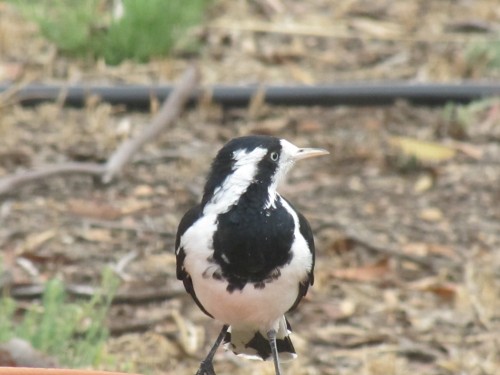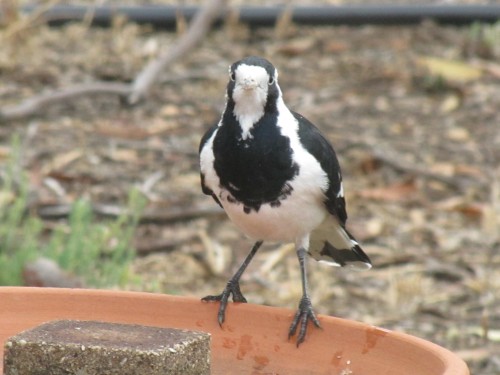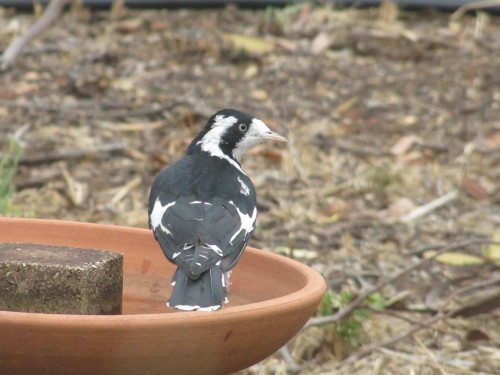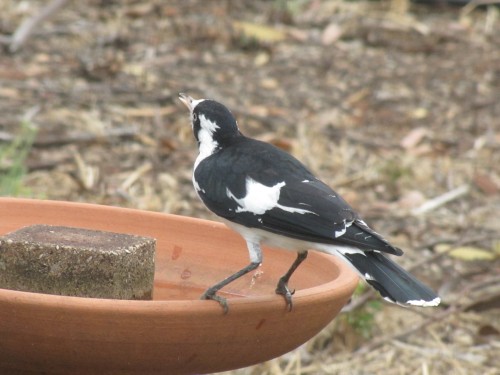Magpie Lark posing
Australian Magpie-larks are a resident breeding species in our garden. The usually make their mud-lined nests in one of the tall eucalypt trees next door, but some years ago they decided that one of our trees was suitable.
Despite not gracing us with their lovely nests, I regard them as a resident species. We see them in our garden every day and they are frequent visitors to our bird baths, especially on hot days. And we’ve had plenty hot days over this summer, including a record breaking series of heat-waves.
During one visit last week I managed this series of photos of a female as she came to the bird bath. Usually they come in pairs, calling loudly as they approach and then drink.
Birds in the heat
Southern Australia is experiencing a series of very hot days since Christmas. Here in Murray Bridge, South Australia, we have experienced most days over the temperature of 35C (95F) with several days getting as high as 45C (113F). It’s been hot, very hot. On days like that I appreciate the fact that I don’t have to go out to work in the sun. I can hunker down inside, get on with my reading or writing with the air conditioning drifting cool air throughout the house.
Not so for our bird life. Many of our wonderful garden birds really suffer during such hot spells. I keep our various bird baths topped up with clean fresh water, and there is a constant stream of birds visiting for a drink, and often for a splash. The Magpie Larks (see photo above) are really keen to come to the bird bath in our front garden. We have a good view of this spot from our sun room which also doubles as a bird hide suitable for photography as well.
The Magpie Larks don’t have the water all to themselves. The local resident Australian Magpies also love to come for a drink and to bathe. The magpies can be very bossy, too. They like to either stand in the water – or sit in the water, often for an hour or more at a time. No sharing, just exclusive occupation.
Perhaps I need to set up a booking system.
Portrait of a Magpie Lark
I like having several bird baths strategically placed around our garden. I especially like those we’ve placed with a good view from our sun room where we often sit to have our meals.
During hot weather especially there is a constant stream of birds of many species which come to drink from or bath in the water. On more than a few occasions I have raced off to get my camera for more photos to share here. On this occasion a Magpie Lark posed just right for a good portrait shot as he paused from drinking.
The white eyebrow indicates that this is the male of a resident breeding pair in our garden. They make a delicate bowl-shaped mud nest, usually quite high up in nearby mallee trees.
Magpie Lark washing its food
In recent weeks we have had a minor locust plague. They weren’t in numbers sufficient to cause us great inconvenience, not like some other rural areas of South Australia in recent months. As they moved in we were delighted to see some of our resident Australian Magpies gorging themselves on this feast.
A few days ago, however, we saw an Australian Magpie Lark catch a locust and bring it to one of our bird baths. We were having lunch at the time and watched fascinated as this bird proceeded to wash its food in the water. I had heard of some birds species doing this, but this was the first time I’d actually witnessed it. Pity the camera wasn’t handy at the time.
Australian Magpie Lark nest
Australian Magpie Larks are a resident bird species in our garden. We see our two on a daily basis as they scratch around in the garden looking for their food. When they both call to each other is can be quite noisy, especially when they are under the back veranda, a place they think is their own.
Earlier in the year they commenced a mud nest in a tall tree next to our clothes line. They were about to lay some eggs when we had several days of heavy rain accompanied by wild winds. Their nest was destroyed by the weather. When it calmed down they set about constructing a replacement. This time they were successful in raising a brood.







